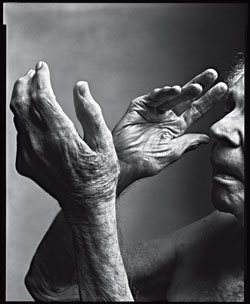
When Merce Cunningham was a young man, time was a pesky element he could seemingly bend to his will. Suspended in the air in a stag leap—one leg crooked forward, the other kicked back, torso erect, arm defiantly raised—he looked capable of hanging in space for as long as he wished. With his penetrating, otherworldly gaze, halo of dark curls, and fierce elegance, he quite literally transfixed audiences. A story goes that in his early days with Martha Graham’s company, one of her assistants pointed to Cunningham and complained, “Martha, he’s doing it all wrong!” To which Graham replied, “Leave him alone. He’s beautiful.”
Cunningham—who, like Graham, found his greatest fame as a choreographer—turns 90 this week. His face has relaxed into folds, his hair now sits in tufts of gray on his great balding head, and his voice has softened considerably. But he continues to teach class twice a week, and his counts remain insistent and direct. On Thursday, Nearly Ninety—a new evening-length work and his longest in a while—opens at BAM, with a score composed by Sonic Youth, John Paul Jones of Led Zeppelin, and mixed-media sound artist Takehisa Kosugi. The artists will be approximating, as much as possible, the philosophy of Cunningham’s creative and life partner, composer John Cage, who died in 1992. And as with every performance since Cunningham teamed with Cage, he and his dancers will first hear the music at dress rehearsal.
In the fifties, Cunningham and Cage developed a revolutionary approach to modern dance that eschewed traditional collaboration. Inspired by the I Ching and its emphasis on chance, the choreography is based on the simple idea that music and dance—both arts that move in time—should operate independently. Trained like every dancer to follow the music, even Cunningham found his new approach challenging. He remembers one early rehearsal when he and Cage came together in the studio with their respective parts. “I did what I thought was a very strong movement,” says Cunningham, “and there was no sound at all. A moment later, John made this thunderous sound on the piano which didn’t fit to what I had done, but emphasized it very much. It was a way of thinking about the connection between sound and vision like the way thunder and lightning are.”
In Cunningham’s world, dancers are not characters but spatial objects moving in time. And though they may not follow a melody, they ride waves of physical rhythm in a similar way. Karole Armitage, now a seminal modern choreographer and a five-year veteran of the company, says the Cunningham technique was “totally natural. Merce figured it out; it’s just so deeply right with the laws of physics and our natural selves. As he pointed out, everything is dance movement—walking is dance—it’s just how you incorporate it into the bigger picture. And we all walk without music.”
At once liberating and maddeningly controlled (“There’s no improvisation in the movement; it’s all very clearly defined,” says Trevor Carlson, executive director of Cunningham’s company), Cunningham’s choreography is defined by a focus on the shifting of weight, the centrality of the torso, and an almost balletic cleanness of line. Pure and efficient, the dancers’ movements belie the great exertion required. Such spartan elegance extends to his stage, which he keeps clean and open (any set usually comes in the form of a flat backdrop), and the simple costumes, nearly always unitards (by Romeo Gigli’s design firm for the BAM show). Mikhail Baryshnikov, who photographed the company for his forthcoming book Merce My Way, says Cunningham told him he does this “because he wants to ‘see it.’ ” Adds Baryshnikov: “Merce always seems to be ahead of others, whether or not that is his goal. He attracts people who almost expect to be exposed to something previously unknown to them.”
Cunningham is, of his generation of choreographers, just about the last man standing. Most of his great friends and collaborators are gone (including Robert Rauschenberg, who designed some of his sets). And he can no longer dance his own work (he uses a computer tool called DanceForms that allows him to see how a combination might work before he gives it to dancers). But his inspiration, apparently, remains undiminished. “Mostly it comes from looking at birds and animals,” says Cunningham. “Anytime I see movement, even someone in the street who has an odd walk, I try to figure out, ‘What is this?’ ” It’s an example of how, as Carlson says, Cunningham continues to live in the present, unconcerned with what the future might hold, or how he survived to this point. “It just happened,” Cunningham says. “You keep thinking, ‘Well, I guess I’ll do that.’ And here you are.”
Nearly Ninety
Choreography by Merce Cunningham.
BAM. April 16 through 19.